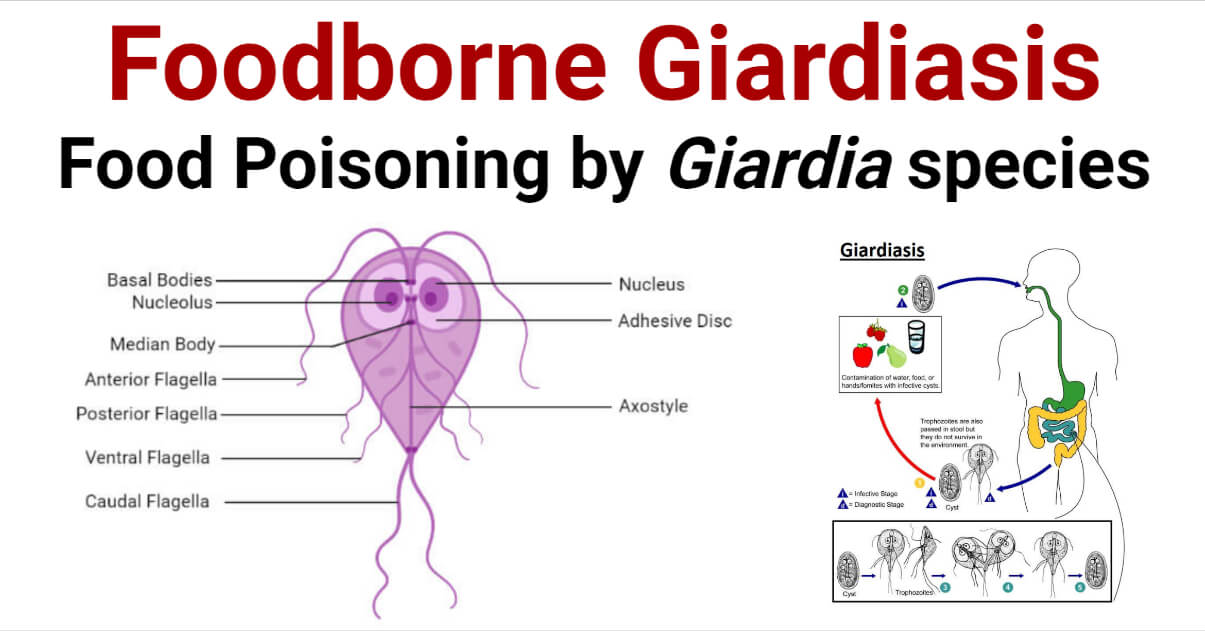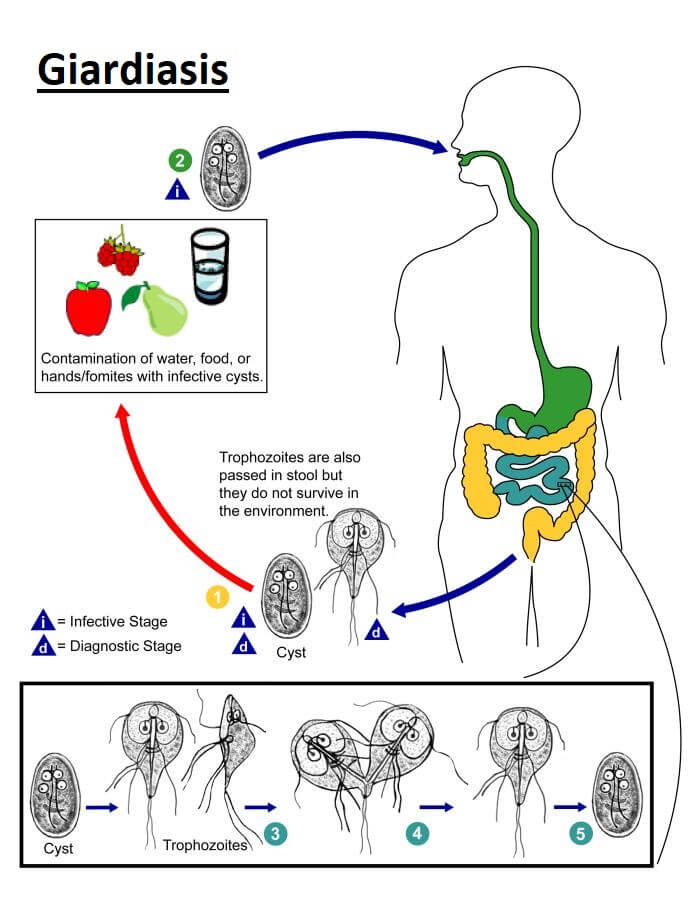- Parasites are widely spread in the environment and are responsible for causing diseases associated with diarrheal illness.
- Food-borne and water-borne parasites are mainly associated with the disease and are the greatest concern in food production.
- Parasitic protozoans cause the greatest risk to human health and economic loss to the nation mainly in developing nations.
- Some of the threat-causing parasitic protozoans to humans are Cryptosporidium, Cyclospora, Giardia, and Toxoplasma.
- Giardia is the primary known parasite associated with human disease and many epidemiological cases have been reported every year.
- Giardiasis causing species that infect humans and other mammals are Giardia duodenalis, Giardia lamblia, Giardia intestinalis and Giardia muris.
- Many food-borne parasitic cases occur each year but very few cases are reported which may be due to the limitation of surveillance and detection methods.

Interesting Science Videos
Sources of contamination of Foodborne Giardiasis
- The main source of contamination is the feces of pets, livestock, and wild animals and is commonly transmitted through the fecal-oral route.
- Giardia cysts are also found in sewage effluent and shallow spring water as well as the cysts are very infectious and can remain for a long period in a cool and damp place.
- Giardia is resistant to chlorine and can survive some common water treatments creating a great risk to water supplies.
- They can be removed by filtration process but Cryptosporidium cannot be removed by filtration because of their smaller size.
Characteristics of Giardia
- Flagellated protists
- Tumbling motility
- Diplomonads i.e, two bodies having individual nuclei
- Mitochondria replaced by mitosome
- Metabolizes by anaerobic glycolysis
- The life cycle completes at two stages: a reproductive trophozoite and a cyst stage.
- Reproduces asexually
- The reproductive trophozoite is 9 – 21 µm long and cysts are 9 – 12 µm long
- Giardia cysts are susceptible to disinfectants like chlorine, iodine, and chlorine dioxide.
Clinical manifestations of Foodborne Giardiasis
- The infectious dose of Giardia is 10 to 100 cysts and the symptoms usually begin within 1 to 2 weeks of infection.
- Symptom starts with diarrhea, nausea, bloating of the stomach, abdominal cramps, malabsorption, and flatulence.
- In severe conditions, dehydration and weight loss might lead to chronic infection and even death.
- Some cases may occur where the patients are asymptomatic carriers but the disease only lasts for 5 days or a week.
Pathogenesis of Giardia species

- The life cycle of Giardia completes in two-stage, first the cysts that initiate infection, and the second vegetative trophozoite which replicates and causes disease.
- The cysts are environmentally resistant especially at low temperatures because of their outer filamentous layer made of N-acetyl-galactosamine and three proteins namely CWPs 1 – 3 which allow them to survive for a long time.
- About 10 to 100 cysts are capable of causing infection when it passes through the stomach acid and reaches the duodenum.
- After entering the duodenum, two trophozoites are formed from each cyst and colonize in the small intestine by absorbing essential nutrition and causing illness to the host.
- Giardia reproduces asexually, therefore, trophozoites replicate by the mode of binary fission and are tetraploid i.e, contain four sets of a chromosome.
- The above cycle is followed by excystation when the cyst passes through the stomach’s acidic environment to the duodenum and in the small intestine, and encystation takes place.
- In response to the trophozoite, T lymphocytes are activated by the body’s immune system which disrupts the epithelial microvilli and shortens them.
- It also disrupts the epithelial tight junctions that lead to an increase in permeability and diarrhea.
- The cyst also goes through bile salt and cholesterol starvation, starting its replication and getting divided into two trophozoites and infecting the other host.
- It is also evident that the host acquires resistance to the infection from an effective immune response.
- The organism is reported to have adapted to the different intestinal environments according to their antigenic variation.
- Although the organism does not produce any toxins or virulence factors, some organisms with variant-specific proteins (VSPs) build resistance to antibodies.
Epidemiology of Foodborne Giardiasis
- The protozoan parasite Giardia causes approximately 4 to 20 cases of outbreak per 100,000 population every year and most are reported to be caused by the fecal-oral transmission route.
- Giardia is reported at the 11th position out of 24 foodborne parasites according to the Food and Agriculture Organisation (FAO) and WHO.
- The epidemiology of giardiasis is more prevalent in developing countries and is also associated with environmental and climatic conditions.
- Children under 5 years are at high risk as compared to adults and about 60-80% of infections are asymptomatic, however, chronic infection is less than 4%.
- In Peru, 95% of children aged under 2 years were infected but after treatment, the infection reoccurred within 6 months.
- The illness is usually asymptomatic and leads to stunting growth in children at an early stage of growth.
- Recently, a large outbreak has been reported in Bergen, Norway infecting more than 3000 people which was due to the consumption of contaminated drinking water.
- It was reported to be a waterborne outbreak as the excretion dose is higher than the infective dose per day.
- An infected person excretes up to 109 cysts per day but the infective dose required to cause infection is 10 to 100 cysts at a time.
- The possible rate of contamination is high in developing countries where people consume tap water, shallow wells, and surface water.
- These water sources are rich in zoonotic parasites and when consumed without purification lead to human infection.
- The giardiasis infection usually peaks in the late summer as the consumption of water is high at this time and most children are affected in daycare centers.
- An outbreak that occurred in Minnesota was from the consumption of home-canned salmon infecting 60 employees at a school.
- But the outbreak was not reported as giardiasis as the transmission was asymptomatic carriers of Giardia.
Detection Methods of Giardia species
- The Giardia cysts in feces samples can be identified by the use of a microscope but this traditional method lacks specificity and sensitivity.
- Immunoassay methods such as enzymatic immunoassays (EIAs) and immunochromatographic tests are also used but they also lack specificity due to the cross-reaction between antibodies.
- The most widely used method by the US Environmental Protection Agency (EPA) is the separation of cysts by an immunomagnetic method.
- After separation, the cysts are visualized under a microscope by staining them with fluorescent dye and differential interference contrast (DIC).
- The PCR-based method offers improved specificity and sensitivity as compared to other detection methods as it identifies the pathogens at the species and genotype level.
Prevention and Control measures of Foodborne Giardiasis
- Symptomatic infections are easy to treat but asymptomatic infection is hard to detect and are observed once it becomes chronic.
- The first choice for treatment is metronidazole, nitroimidazole and tinidazole.
- Tinidazole is most effective as it has high efficacy in a single dose as compared to metronidazole which requires 5-10 days to reach the effective dose.
- For pregnant women, paromomycin is recommended as it is less effective than nitroimidazole and nonabsorbed aminoglycoside.
- Human giardiasis can be prevented by breaking the life cycle of Giardia from transmitting which can be done by providing the treated municipal water supplies.
- Municipal water supplies process the water by coagulation, clarification, filtration and chlorination which is highly effective at removing cysts and inactivating other pathogens.
- Giardia cysts are also inactivated by heat treatment at 55°C and above for 5 mins and the use of household portable filters of size less than 1µm is also effective in filtering cysts.
- Washing hands and use of protective gloves by food handlers while preparing food also prevents the risk of asymptomatic contamination.
References
- Adam, R. D. (2014). Protozoa: Giardia lamblia. Encyclopedia of Food Safety, 37–44.
- Dawson, D. (2005). Foodborne protozoan parasites. International Journal of Food Microbiology, 103(2), 207–227.
- Ryan, U., Hijjawi, N., Feng, Y., & Xiao, L. (2018). Giardia: an under-reported foodborne parasite. International Journal for Parasitology.
- Rodriguez-Morales, A. J., Bolivar-Mejía, A., Alarcón-Olave, C., & Calvo-Betancourt, L. S. (2016). Parasites in Food: Illness and Treatment. Encyclopedia of Food and Health, 213–218.
- Bouzid, M. (2014). WATERBORNE PARASITES | Detection of Food- and Waterborne Parasites. Encyclopedia of Food Microbiology, 773–781.
- Botas, J., & Melo-Cristino, J. (2003). PARASITES | Illness and Treatment. Encyclopedia of Food Sciences and Nutrition, 4356–4360.
